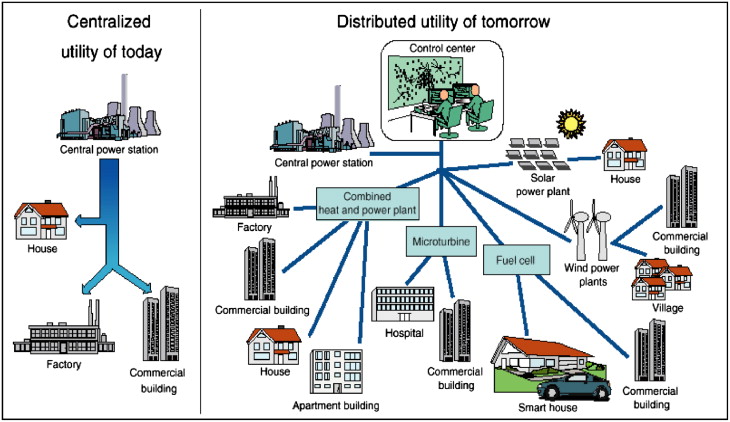The introduction of DG in systems originally radial and designed to operate without any generation on the distribution system, can significantly impact the power flow and voltage conditions at both, customers and utility equipment.
These impacts can be manifested as having positive or negative influence, depending on the DG features and distribution system operation characteristics.
A method to asses this impact, is based on investigate the behaviour of an electric system, with and without the presence of DG. The difference between the results obtained in these two operating conditions, gives important information for both, companies in the electric sector and customers.
1) Impact of DG on Voltage Regulation:
· Radial distribution systems regulate the voltage by the aid of load tap changing transformers (LTC) at substations, additionally by line regulators on distribution feeders and shunt capacitors on feeders or along the line. Voltage regulation is based on one way power flow where regulators are equipped with line drop compensation.
· The connection of DG may result in changes in voltage profile along a feeder by changing the direction and magnitude of real and reactive power flows. Nevertheless,
· DG impact on voltage regulation can be positive or negative depending on distribution system and distributed generator characteristics as well as DG location
· There are two possible solutions facing this problem: the first solution is to move the DG unit to the upstream side of the regulator, while the second solution is adding regulator controls to compensate for the DG output.
· The installation of DG units along the power distribution feeders may cause overvoltage due to too much injection of active and reactive power. For instance, a small DG system sharing a common distribution transformer with several loads may raise the voltage on the secondary side, which is sufficient to cause high voltage at these customers
2) Impact of DG on Losses:
One of the major impacts of Distributed generation is on the losses in a feeder. Locating the DG units is an important criterion that has to be analyzed to be able to achieve a better reliability of the system with reduced losses
3) Impact of DG on Harmonics:
· A wave that does not follow a “pure” sinusoidal wave is regarded as harmonically distorted. Harmonics are always present in power systems to some extent. They can be caused by for instance: non-linearity in transformer exciting impedance or loads such as fluorescent lights, AC to DC conversion equipment, variable-speed drives, switch mode power equipment, arc furnaces, and other equipment.
· Impact of DG on Short Circuit Levels of the Network
· The presence of DG in a network affects the short circuit levels of the network. It creates an increase in the fault currents when compared to normal conditions at which no DG is installed in the network
· The fault contribution from a single small DG is not large, but even so, it will be an increase in the fault current. In the case of many small units, or few large units, the short circuits levels can be altered enough to cause miss coordination between protective devices, like fuses or relays. The nature of the DG also ffects the short circuit levels.
· The highest contributing DG to faults is the synchronous generator. During the first few cycles its contribution is equal to the induction generator and self-excited synchronous generator, while after the first few cycles the synchronous generator is the most fault current contributing DG type. The DG type that contributes the least amount of fault current is the inverter interfaced DG type, in some inverter types the fault contribution lasts for less than one cycle.


